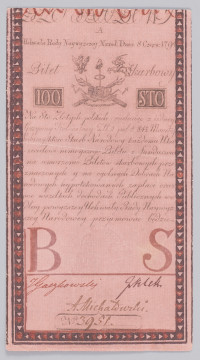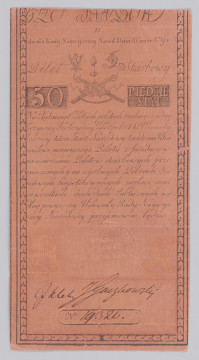
Treasury ticket - 500 Polish zlotys
1794
National Museum in Lublin
Part of the collection: Paper money of the Kościuszko Uprising and the Duchy of Warsaw
Paper money has a relatively long history. It first came into circulation as early as the Middle Ages in China. The first European country to introduce paper money was Sweden in the 17th century. Initially, banknotes appeared in emergency situations. This was the case both in 14th-century China and in 17th-century Sweden. The latter was soon followed by England (1694) and France (1716). In Poland the idea of introducing banknotes appeared during the reign of Stanisław August Poniatowski. In 1774, during a session of the Sejm, Jan Aleksander Kraszewski presented a proposal on Establishment of a Paper with the Stamp of the Republic of Poland. The proposal was rejected. Nevertheless, in later years the idea was repeated, along with a proposal to establish a central bank. The issue was most fully elaborated by Jędrzej Kapostas in his publication of 1790, A Plan to Establish a Project of a National Bank, to the Excellent Deputation of the Project of National Economics Given. Despite the King's support, the ideas of establishing a central bank and issuing paper money was not taken up in the debates of the Great Sejm. It was only the outbreak of the Kościuszko Uprising and the need to finance military operations that led to the creation of the Directorate of Treasury Tickets, the first institution to introduce Polish paper money into circulation, set up on 8 April 1794.
Among the treasury tickets issued were also those with a face value of 5 groszy. They had a poor graphic design. They were printed on handmade paper from the Paper Factory in Jeziorna near Warsaw. The sheets had a large watermark depicting the coats of arms of Poland and Lithuania and the inscription ‘Jeziorna’ placed between them. Thirty-six images of either the obverse or the reverse were printed on individual sheets and then both parts were cut out and glued together. To prevent forgery, a mark in the form of the letter 'V' inscribed in a stylised oval frame was placed on the top of the reverse. The ink used for this was dissolved by the glue and transferred to the obverse side. Contrary to the reference to the resolution of 13 August 1794, tickets with the face value of 5 groszy did not enter circulation until 10 October 1794, four weeks before the fall of the uprising.
Leszek Poniewozik
Author / creator
Dimensions
cały obiekt: height: 45 mm, width: 65 mm
Object type
paper money
Technique
woodcut
Material
paper
Creation time / dating
Creation / finding place
Owner
The National Museum in Lublin
Identification number
Location / status

1794
National Museum in Lublin

1794
National Museum in Lublin

1794
National Museum in Lublin
DISCOVER this TOPIC
National Museum in Lublin
DISCOVER this PATH
Educational path